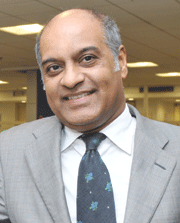Dilip Thakore interviewed Khozem Merchant, a former Financial Times journalist and currently president of Pearson India, in the company’s 30,000 sq. ft office premises in Noida, NCR. Excerpts:
 Until the recent acquisition of TutorVista last month, the Pearson Group has maintained a low profile in India. What is your business mix in India?
Until the recent acquisition of TutorVista last month, the Pearson Group has maintained a low profile in India. What is your business mix in India?
Until three years ago, Pearson India was a traditional K-12, and higher education textbooks publishing business. In 2008, our senior management identified India as a strategic market. We promised ourselves at the start of our India initiative in 2008 that we’d create a wide-spectrum services business within three years and that’s what we have done. Now we have a cluster of businesses in India that covers testing and assessment, English language testing, teacher training, content publishing, vocational training, online tutoring, test prep and school management. So it’s a good start.
What were the factors which prompted Pearson’s acquisition of a 76 percent stake in TutorVista?
Pearson has held a minority investment in TutorVista since June 2009. We liked the company because of its deep understanding of technology, close-ness to the consumer, and management of K-12 schools. There are four reasons why we acquire and Tutor-Vista neatly fits all four. It’s in a growing market; that market is large; the business is scalable; and it lends itself to the wholesale application of technology. Over the past 18 months we have worked closely and comfortably with Ganesh and Meena, the founders of TutorVista, and come to admire their entrepreneurial skills and execution capabilities.
Learning outcomes in k-12, especially in government schools are abysmal. What can Pearson India contribute towards raising teaching-learning standards in Indian school education?
Pearson is engaged with education and learning in the widest sense in 60 countries where we share global practices among our 37,000 employees. In mature OECD countries, for example, Pearson has wide experience of working with government, education ministries, public bodies, municipal corporations, local authorities and quangos (quasi-NGOs), which means we are comfortable working with multiple stakeholders in education. In India, we are already engaging with government and public sector education bodies, sharing our knowledge and expertise. I am confident that our collaboration with private and public sector institutions and organis-ations will grow constructively in India. I’m excited because the education opportunity in India is huge, immediate and transformational.
Pearson India is widely perceived as a textbooks publisher. To what extent are you involved in k-12 and other areas of learning?
Historically we have been textbook publishers in India. But globally Pearson is a technologically driven education services business. And we are trans-forming our profile in this country, matching our global capabilities with the larger India opportunity. For example, through skills building, which will give India a competitive advantage in services and manufacturing; secondly, we bring schools management and improvement capabilities to India; and thirdly, we have introduced new technologies to measure learning and make India’s skilled workers globally mobile. This is a tipping point moment for Indian education to emerge as a knowledge power and the world’s largest pool of skilled labour.
To what extent is the opacity of government, especially of state government policies an impediment to Pearson India’s plans to deepen its engagement with Indian education?
Government policies at the Centre and in the states are moving decisively in favour of reform and upgradation of education in all segments, especially K-12. The climate in Indian education is profoundly conducive for all types of educators — philanthropists, corporates and NGOs.
How optimistic are you about Indian education?
Very. I think similar to telecom in the 1990s, education needs to undergo the telescoping of time. Which means a lot needs to be achieved, much of it unprecedented, in a short span of time. Indian families have always been committed to making great sacrifices for children’s education. What is new today is that they are aware of defici-encies in the delivery and at the same time have access to quality world-class learning. There’s never been such widespread recognition of the correlation between education, better jobs and poverty reduction. Finally, there’s the government’s boldness in addressing the issue, with dynamic policy making, a hand of collaboration extended to corporates and an unprecedented enabling environment.